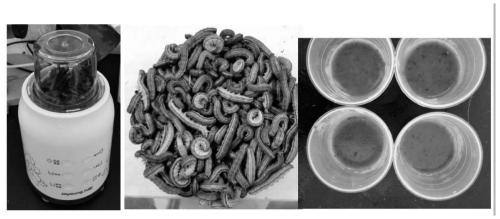A kind of semi-artificial feed breeding method of ladybugs
A technology for artificial feed and aphids, which is applied to the field of artificial breeding of natural enemy insects, can solve the problems of high mortality of young larvae, a large number of insect sources, and the young larvae of lady beetles are not easy to prey, etc., and achieve the effect of simple preparation method and population expansion.
- Summary
- Abstract
- Description
- Claims
- Application Information
AI Technical Summary
Problems solved by technology
Method used
Image
Examples
Embodiment 1
[0064] Embodiment 1: the preparation of chelonian ladybug artificial diet
[0065] 1. For the formula of artificial feed, see Table 1.
[0066] Table 1: Formula of artificial diet for ladybug
[0067]
[0068] 2. Preparation method:
[0069] (1) Raise armyworms with corn seedlings, take the fifth to sixth instar armyworms, and freeze them at -20°C.
[0070] (2) Put the frozen armyworm into the Joyoung cooking machine and smash it. Freeze again at -20°C, add aphids and crush again.
[0071] (3) Weigh the crushed armyworm powder, aphid powder, sucrose, yeast powder, honey, olive oil, methylparaben, potassium sorbate, ascorbic acid, vitamin B complex, Webster's salt, as group A substance;
[0072] (4) Add 0.37 g of agar to 25 ml of water, heat in a microwave oven for 40 seconds, shake well and continue heating for 40 seconds.
[0073] (5) Shake the agar water well, cool it down to about 60°C, mix the substances in group A, heat and stir evenly with a stirrer.
[0074] (...
Embodiment 2
[0076] Embodiment 2: the refrigeration processing method of aphid
[0077] The cold storage method of aphids is as follows: when aphids occur in large numbers, after collecting aphids, take a water bath at 55°C for 8 minutes, dry the water, and store at -20°C. After the aphids are bathed in water, it can effectively prevent the melanization of the hemolymph, thereby improving the fresh-keeping quality.
[0078] It is very critical to carry out water bath treatment to aphids before refrigeration treatment, for this reason, the present invention has carried out comparative test, and the results are shown in image 3 , image 3 Among them, A is the frozen P. pea after the water bath, B is the directly frozen P. pea without the water bath, and C is the radish aphid after being frozen in the water bath. Depend on image 3 It can be seen that after the water bath can effectively prevent the melanization reaction of aphid hemolymph, which is beneficial to freshness preservation an...
Embodiment 3
[0083] Embodiment 3: semi-artificial feed breeding mole-shaped ladybug
[0084] In this example, artificial feed and aphids were used to raise together. Firstly, the growth of larvae fed with frozen aphids at different ages, the survival rate of all ages of ladybugs fed with aphids at different ages, and the larval stages of ladybugs were investigated. Daily average and total amount of aphids. The results are shown in Table 3, Table 4 and Table 5 respectively.
[0085] Table 3: Fertility of larvae fed with frozen aphids at different ages
[0086]
[0087]
[0088] Table 4: Survival rate of ladybugs at different ages fed with aphids at different ages
[0089]
[0090] Table 5: The daily average and total amount of aphids in the larval stage of the mole beetle
[0091]
[0092] It can be seen from the above results that adding frozen aphids at the larval stage significantly shortened the developmental period and increased the survival rate compared with feeding wi...
PUM
 Login to View More
Login to View More Abstract
Description
Claims
Application Information
 Login to View More
Login to View More - R&D
- Intellectual Property
- Life Sciences
- Materials
- Tech Scout
- Unparalleled Data Quality
- Higher Quality Content
- 60% Fewer Hallucinations
Browse by: Latest US Patents, China's latest patents, Technical Efficacy Thesaurus, Application Domain, Technology Topic, Popular Technical Reports.
© 2025 PatSnap. All rights reserved.Legal|Privacy policy|Modern Slavery Act Transparency Statement|Sitemap|About US| Contact US: help@patsnap.com



